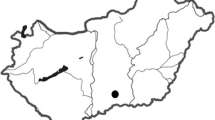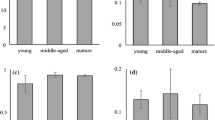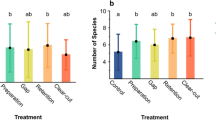Abstract
Cloud forests have high ecological complexity, but their reduced area and exploitation by human communities, make them one of the most endangered ecosystems in Mexico. The spider assemblages of a cloud forest reserve in Chiapas, Mexico, were studied to analyze influence of environmental variables (forest stand structure, temperature and relative humidity) and their temporal variation, on the distribution, abundance, species richness and assemblage structure of spiders. Ten parcels were established for the sampling of spiders and the recording of forest and climatic variables. Spider sampling took place during the dry and rainy seasons. Vegetation data were recorded at the end of the study (except canopy cover, which was registered at the end of each season). Some differences were found among parcels in forest stand structure, but only the density of seedlings showed a high correlation with spider abundance, seemingly seedlings (by its size and architecture) offered numerous supports for the understory spiders’ webs and then promote the settlement of weaver spiders. Also there were some correspondences between the similarity patterns of forest structure and spider assemblages, giving some evidence of a forest structure influence on the integration of spiders’ assemblages. Spider abundance was notoriously higher in the dry season. Other environmental variables had only weak effects on spider variables (abundance and species richness) and assemblage structure. The most abundant families were Tetragnathidae, Theridiidae and Linyphiidae, which were also among the dominant families in other tropical cloud forests, with the latter two also being among the most diverse. As complex ecosystems, tropical cloud forests seem to have complicated interactions with their inhabitant animals, not easy to elucidate.






Similar content being viewed by others
References
Bates D, Maechlet M, Bolker B, Walker S, Christensen R, Singmann H, Dai B (2014). R package version 1.1-7. https://github.com/lme4/lme4/
Breedlove DE (1981) Introduction to the flora of Chiapas, Part 1. California Academy of Science, San Francisco
Cardoso P (2009) Standardization and optimization of arthropod inventories—the case of Iberian spiders. Biodivers Conserv 18:3949–3962. doi:10.1007/s10531-009-9690-7
Challenger A (1998) Utilización y conservación de los ecosistemas terrestres de México: pasado, presente y futuro. Comisión Nacional para el Conocimiento y Uso de la Biodiversidad, Instituto de Biología de la UNAM y Agrupación Sierra Madre S. C., México, D. F
Chamé VER, Reyes-Castillo P, Gómez B (2007) Fauna de Passalidae (Coleoptera: Scarabaeoidea) en el bosque mesófilo de montaña del sureste de Chiapas, México. In: Zunino M, Melic A (eds) Escarabajos, diversidad y conservación biológica. Ensayos en homenaje a Golzalo Halffter vol. 7, S. E. A., Zaragoza, pp 63–68
Colwell RK (2013) EstimateS: statistical estimation of species richness and shared species from samples. Version 9.1.0. http://viceroy.eeb.uconn.edu/estimates/
CONABIO (2010) El bosque mesófilo de montaña en México: amenazas y oportunidades para su conservación y manejo sostenible. Comisión Nacional para el Conocimiento y Uso de la Biodiversidad, Mexico
Corcuera P, Jiménez ML, Valverde PL (2008) Does the microarchitecture of Mexican dry forest foliage influence spider distribution. J Arachnol 36:552–556. doi:10.1636/T05-20.1
Deloya C, Ordoñez-Resendiz MM (2008) Escarabajos (Insecta: Coleoptera). In: Manson RH et al (eds) Agroecosistemas cafetaleros de Veracruz: biodiversidad, manejo y conservación. INECOL e INE-SEMARNAT, Mexico, pp 123–134
Flores-Villela O, Gerez P (1994) Biodiversidad y conservación en México: vertebrados, vegetación y uso de suelo. Comisión Nacional para el Conocimiento y Uso de la Biodiversidad-Universidad Nacional Autónoma de México, Mexico
Foord ASH, Mafadza MM, Dippenaar-Schoeman AS, Van Rensburg BJ (2008) Micro-scale heterogeneity of spiders (Arachnida: Araneae) in the Soutpansberg, South Africa: a comparative survey and inventory in representative habitats. Afr Zool 43:156–174
Gauch HC (1982) Multivariate analysis in community ecology. Cambridge University Press, Cambridge
González-Espinosa M, Meave JA, Ramírez-Marcial N, Toledo-Aceves T, Lorea-Hernández FG, Ibarra-Manriquez G (2012) Los bosques de niebla de México: conservación y restauración de su componente arbóreo. Ecosistemas 21(1–2):36–52
Greenstone MH (1999) Spider predation: how and why we study it. J Arachnol 27:333–342
Gual-Díaz M, Rendón-Correa A (2014) Bosques mesófilos de montaña de México: diversidad, ecología y manejo. Comisión Nacional para el Conocimiento y Uso de la Biodiversidad, Mexico
Halaj J, Ross DW, Moldenke AR (1998) Habitat structure and prey availability as predictors of the abundance and community organization of spiders in Western Oregon forest canopies. J Arachnol 26:203–220
Hammer O, Harper DAT (2014). PAST: Paleontological Statistics Version 3.0. http://folk.uio.no/ohammer/past/
Hancock EG, Marcos-García MA, Rotheray GE (2006) Ptychopteridae—a family of flies (Diptera) new to the Neotropical Region and description of a new species. Zootaxa 68(1351):61–68
Hatley CL, MacMahon JA (1980) Spider community organization: seasonal variation and the role of vegetation architecture. Environ Entomol 9:632–639
Hernández-Baz F, González JM, Vinson SB (2012) Ecology and conservation of Coreura albicosta Draudt, 1916 (Lepidoptera: Erebidae: Actiinae: Ctenuchina), an endemic species of Mexico. Southwest Entomol 37(3):369–378
Hernández-Ortíz V, Dzul-Cauich JF (2008) Moscas (Insecta: Diptera). In: Manson RH et al (eds) Agroecosistemas cafetaleros de Veracruz: biodiversidad, manejo y conservación. INECOL e INE-SEMARNAT, Mexico, pp 95–105
Ibarra-Núñez G, Chamé-Vázquez D (2009) Las arañas del suelo del bosque mesófilo de montaña de la Reserva de la Biosfera del Volcán Tacaná, Chiapas: Efectos de las perturbaciones antropogénicas. Entomol Mex 8:47–52
Ibarra-Núñez G, Maya-Morales J, Chamé-Vázquez D (2011) Las arañas del bosque mesófilo de montaña de la Reserva de la Biosfera Volcán Tacaná, Chiapas, México. Rev Mex Biodivers 82:1183–1193
Jiménez-Valverde A, Lobo MJ (2007) Determinants of local spider (Araneidae and Thomisidae) species richness on a regional scale: climate and altitude vs. habitat structure. Ecol Entomol 32:113–122
Korhonen L, Heikkinen J (2009) Automated analysis of in situ canopy images for the estimation of forest canopy cover. For Sci 55(4):323–334
Kuznetosva A, Bruun PB, Haubo RB (2016) Test in linear mixed effects models. Version 2.0-3.0. https://cran.r-project.org/web/packages/lmerTest//lmerTest.pdf
Larrivée M, Buddle CM (2010) Scale dependence of tree trunk spider diversity patterns in vertical and horizontal space. Ecoscience 17:400–410. doi:10.2980/17-4-3403
Larrivée M, Fahrig L, Drapeau P (2005) Effects of a recent wildfire and clearcuts on ground-dwelling boreal forest spider assemblages. Can J For Res 35:2575–2588. doi:10.1139/x05-169
Long A, Heath M (1991) Flora of the El Triunfo Biosphere Reserve, Chiapas, México: a preliminary floristic inventory and the plant the plant communities of polygon I. Ann Inst Biol Univ Nac Auton Mex Ser Bot 62:133–172
Lucio-Palacio CR, Ibarra-Núñez G (2015) Arañas arboricolas de cacaotales con diferente tipo de manejo en Chiapas, México. Rev Mex Biodiv 86:143–152. doi:10.7550/rmb.41027
Martínez-Camilo R, Pérez-Farrera MÁ, Martínez-Meléndez N (2012) Listado de plantas endémicas y en riesgo de la Reserva de la Biosfera El Triunfo, Chiapas, México. Bot Sci 90(3):263–285
Maya-Morales J, Ibarra-Núñez G (2012) Gremios de arañas de la vegetación del bosque mesófilo de montaña de la Reserva de la Biosfera Volcán Tacaná, Chiapas, México. Entomol Mex 11:53–58
Maya-Morales J, Ibarra-Núñez G, León-Cortés JL, Infante F (2012) Understory spider diversity in two remnants of tropical montane cloud forest in Chiapas, Mexico. J Insect Conserv 16:25–38. doi:10.1007/s10841-011-9391-x
Méndez-Castro FE, Rao D (2014) Spider diversity in epiphytes: can shade coffee plantations promote the conservation of cloud forest assemblages? Biodivers Conserv 23:2561–2577. doi:10.1007/s10531-014-0739-x
Micó E, Gómez B, Galante E (2006) The mesoamerican genus Yaaxkumukia: biogeography and descriptions of new species (Coleoptera: Rutelidae). Ann Entomol Soc Am 99:1–6. doi:10.1603/0013-8746(2006)099[0001:TMGYBA]2.0.CO;2
Morón-Ríos A, Morón MA (2001) La fauna de Coleoptera Melolonthidae de la Reserva de la Biósfera “El Triunfo”, Chiapas, México. Acta Zool Mex 84:1–25
Morse DH (2007) Predator upon a flower, life history and fitness in a crab spider. Harvard University Press, Massachussetts
Nadkarni NM, Wheelwright NT (2000) Ecology and conservation of a tropical cloud forest. Oxford University Press, Nueva York
Nimelä J (1997) Invertebrates and boreal forest management. Conserv Biol 11:601–610
Olvera M, Moreno S, Figueroa B (1996) Sitios permanentes para la investigación silvícola. Universidad de Guadalajara, Jalisco
Pérez M, Tejada C, Silva E (2010) Los bosques mesófilos de montaña en Chiapas: Situación actual, diversidad y conservación. Universidad de ciencias y artes de Chiapas, Tuxtla Gutiérrez
Pinkus MA, Ibarra-Núñez GI, Parra-Tabla V, Garcia-Vallinas JA, Hénaut Y (2006) Spider diversity in coffee plantations with different management in Southeast Mexico. J Arachnol 34:104–112
R Development Core Team (2014) R: A Language and Environmental for Statistical Computing. Versión 3.1.2. http://cran.r-project.org/bin/windows/base/
Riechert SE, Gillespie RG (1986) Habitat choice and utilization in web-building spiders. In: Shear WA (ed) Spiders webs, behaviour, and evolution. Standfor University Press, California, pp 23–48
Rodrigues ENL, Mendonça MS (2012) Spider guilds in the tree-shrub strata of riparian forests in southern Brazil. J Arachnol 40:39–47
Rodrigues ENL, Mendonça MS, Costa-Schmidt LE (2014) Spider diversity responds strongly to edge effects but weakly to vegetation structure in riparian forests of Southern Brazil. Arthropod Plant Interact 8:123–133. doi:10.1007/s11829-014-9294-3
Rotheray GE, Hancock EG, Marcos-García MA (2007) Neotropical Copestylum (Diptera, Syrphidae) breeding in bromeliads (Bromeliaceae) including 22 new species. Zool J Linean Soc 150:267–317
Rypstra AL, Carter PE, Balfour RA, Marshall SD (1999) Architectural features of agricultural habitats and their impact on the spider inhabitants. J Arachnol 27:371–377
Rzedowski J (2006) Vegetación de México. Comisión Nacional para el Conocimiento y Uso de la Biodiversidad, Mexico
Samu F, Sunderland KD, Toppingm CJ, Fenlon SJ (1996) A spider population in flux: selection and abandonment of artificial web sites and the importance of interespecific interactions in Lephthyphantes tenuis (Araneae: Linyphiidae) in wheat. Oecologia 106:228–239
Samu F, Lengyel G, Szita É, Bidló A, Ódor P (2014) The effect of forest stand characteristics on spider diversity and species composition in deciduous-coniferous mixed forests. J Arachnol 42:135–141. doi:10.1636/CP13-75.1
Sanzone DM, Meyer JL, Marti E, Gardiner EP, Tank JL, Grimm NB (2003) Carbon and nitrogen transfer from a desert stream to riparian predators. Oecologia 134:238–250
Scatena FN, Bruijnzeel L, Bubb P, Das S (2011) General perspectives: setting the stage. In: Bruijnzeel L, Scatena F, Hamilton L (eds) Tropical Montane cloud forests: science for conservation and management. Cambridge University Press, Cambridge, pp 3–11
Scharff N, Coddington JA, Briswold CE, Hormiga G, Bjørn PDP (2003) When to quit? Estimating spider species richness in a Northern European deciduous forest. J Arachnol 31:246–273
Schuldt A, Fahrenholz N, Brauns M et al (2008) Communities of ground-living spiders in deciduous forests: does tree species diversity matter? Biodivers Conserv 17:1267–1284. doi:10.1007/s10531-008-9330-7
Schuldt A, Both S, Bruelheide H et al (2011) Predator diversity and abundance provide little support for the enemies hypothesis in forests of high tree diversity. PLoS ONE 6:e22905. doi:10.1371/journal.pone.0022905
Schuldt A, Bruelheide H, Härdtle W, Assmann T (2012) Predator assemblage structure and temporal variability of species richness and abundance in forests of high tree diversity. Biotropica 44:793–800. doi:10.1111/j.1744-7429.2012.00876.x
Schuldt A, Assmann T, Schaefer M (2013) Scale-dependent diversity patterns affect spider assemblages of two contrasting forest ecosystems. Acta Oecol 49:17–22. doi:10.1016/j.actao.2013.02.009
Sorensen LL (2003) Stratification of the spider fauna in Tanzania forest. In: Basset Y, Novotony V, Miller SE, Kitching RL (eds) Arthropods of tropical forest spatio-temporal dynamics and resource use in the canopy. Cambridge University Press, Cambridge, pp 92–101
Torres IL, Piñera EJN, Marcelino D, Andrade G, Aldán EC (2004) Ecología de Tapirus bairdii (Perissodactyla: Tapiridae) en la Reserva de la Biósfera El Triunfo (Polígono I), Chiapas, México. Acta Zool Mex 20:1–21
Ubick D, Paquin P, Cushing PE, Roth V (2005) Spiders of North America: an identification manual. American Arachnological Society, Keene
Valenzuela-González J, Quiroz-Robledo L, Martínez-Tlapa DL (2008) Hormigas (Insecta: Hymenoptera: Formicidae). In: Manson RH et al (eds) Agroecosistemas cafetaleros de Veracruz: biodiversidad, manejo y conservación. INECOL e INE-SEMARNAT, Mexico, pp 107–121
Vandame R, Ayala R, Esponda J, Balboa C, Guzmán MA (2013) Diversidad de abejas: El caso de la reserva de la Biosfera El Triunfo. Comisión Nacional para el Conocimiento y Uso de la Biodiversidad (CONABIO), La biodiversidad en Chiapas: Estudio de estado, vol 2. CONABIO/Gobierno del Estado de Chiapas, Mexico, pp 233–240
Williams G (1991) Nota sobre la estructura del estrato arboreo del bosque mesofilo de montana en los alrededores del campamento “El Triunfo”, Chiapas. Acta Bot Mex 13:1–7
Williams-Linera G (2012) El bosque de niebla del centro de Veracruz: ecología, historia y destino en tiempos de fragmentación y cambio climático. CONABIO-Instituto de Ecología, A. C., Xalapa
Wise DH (1993) Spiders in ecological webs. Cambridge University Press, Cambridge
World Spider Catalog (2016) World Spider Catalog. Natural History Museum Bern. http://www.wsc.nmbe.ch/ version 17.0. Accessed 13 Mar 2016
Ziech TM, Roth M (2008) Influence of environmental parameters on small-scale distribution of soil-dwelling spiders in forests: what makes the difference, tree species or microhabitat? For Ecol Manage 255:738–752. doi:10.1016/j.foreco.2007.09.060
Acknowledgments
We thank G. G. Angulo and J. F. Gómez (ECOSUR) for the assistance in collecting specimens. Thanks to Miriam Janette Gonzáles García and rangers Ismael, Edilberto, Ramiro and Enelfo (Reserva de la Biosfera El Triunfo, Comisión Nacional de Áreas Naturales Protegidas, CONANP) for the logistic support and access to the camp in El Triunfo Biosfere Reserve. F. J. Valle-Mora (ECOSUR) assisted in the statistical analyses. Three reviewers suggested valuable improvements to the manuscript. Spiders specimens were collected in El Triunfo Biosphere Reserve under permit of SEMARNAT to G. Ibarra-Núñez (SGPA/DGVS/00329/14). The Consejo Nacional de Ciencia y Tecnología (CONACYT) of Mexico supported this project (179476) and supported E. F. Campuzano with a master fellowship.
Author information
Authors and Affiliations
Corresponding author
Additional information
Handling Editor: Heikki Hokkanen.
Rights and permissions
About this article
Cite this article
Campuzano, E.F., Ibarra-Núñez, G., Chamé-Vázquez, E.R. et al. Understory spider assemblages from a cloud forest in Chiapas, Mexico, and their relationships to environmental variables. Arthropod-Plant Interactions 10, 237–248 (2016). https://doi.org/10.1007/s11829-016-9426-z
Received:
Accepted:
Published:
Issue Date:
DOI: https://doi.org/10.1007/s11829-016-9426-z




